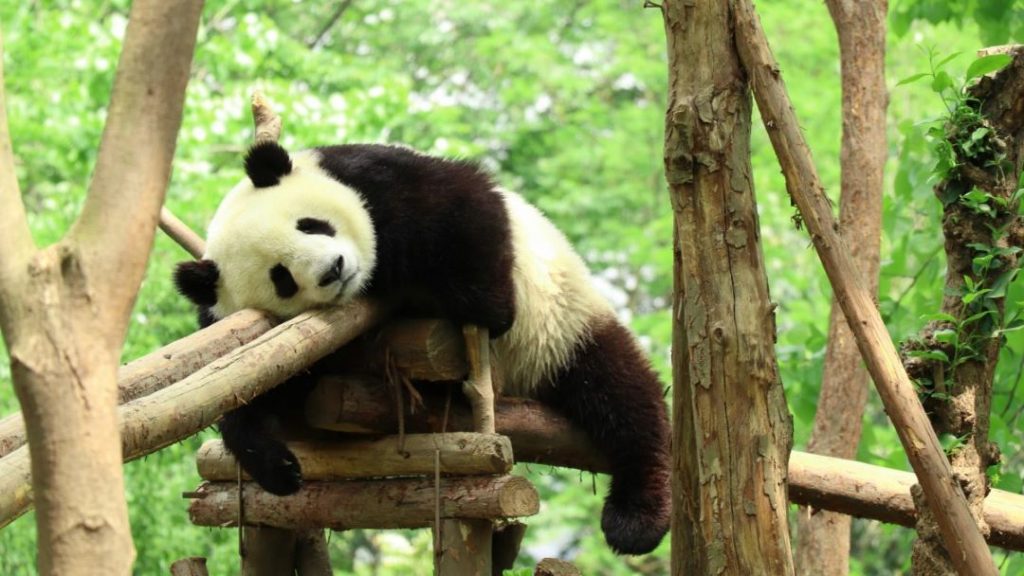The giant panda, an animal with black and white fur and a round body, has always been a national treasure of China. The case of protecting Chinese pandas is not only a model for protecting endangered species in the world but also an indispensable part of Sino-foreign friendship and exchanges.
So, why did pandas become China’s national animals? Let’s explore the mystery behind this Chinese symbol.
Table of Contents
The Giant Panda: a National Animal of China
A national treasure is the treasure of a country. Both items and non-items can be listed as national treasures.
Countries around the world have their national treasures, such as the giant panda in China, the polar bear in Russia, the beaver in Canada, the kiwi in New Zealand, and the American eagle in the United States.
Although they differ in appearance, ecological environment, and other aspects, they also have certain commonalities, such as rarity, uniqueness, and embodying cultural meanings. These commonalities all reflect the widespread concern of human society towards precious creatures.
Each national treasure is specially protected by its host country. They are mostly regarded as priceless treasures, serving as the pride and symbol of the country.
As China’s national treasure, the giant panda is not only one of China’s rare wild animals but also famous worldwide for its cute appearance and unique ecological characteristics.
Regarded as a symbol of the country with unique and profound significance, pandas play an important role in China’s social and cultural context.
Why Giant Pandas Become Chinese National Treasures
The giant panda, this furry creature, is not only a precious treasure on Chinese soil but also a focal point of attention around the world.
As a national treasure of China, pandas are not only the national treasures of China but also a valuable asset to the world, carrying the common care of humanity for the natural environment and life.
There are diverse reasons why giant pandas can become China’s national treasure.
From its unique ecological role and rich cultural symbols to a bridge symbolizing international friendship, giant pandas have gradually formed irreplaceable value in the process of history.
#1: Long History

The giant panda is a very mysterious animal. It existed in the late Miocene 8 million years ago and has survived under natural conditions of natural selection and cruelty to this day.
Animals of the same era as the giant panda, such as the saber-toothed elephant and saber-toothed tiger, have long been extinct, so the giant panda is known as a “living fossil” and is considered a national treasure of China.
In addition, its living habits and reproductive methods also have high research value, so the giant panda has become the research object of many scientists internationally.
#2: Rarity

Rarity is one of the common characteristics of national treasures in most countries. The national treasure of Malaysia, the Malay tapir, currently with only some 3000, has been listed as an endangered species.
Due to environmental changes, the number of giant pandas is currently less than 2000, far less than that of Malay tapir. That is why they are highly endangered species.
The reproductive ability of giant pandas is poor, and the survival rate of the young pandas is low, so it naturally became a national treasure of China.
Moreover, the panda is also one of the rarest wild bear species in the world. Protecting it is also of great significance for maintaining ecological balance and biodiversity.
Read More: Why are Giant Pandas Endangered? (5 Reasons)
#3: Endemism
The giant panda is an endemic species in China, only distributed in the mountainous areas of Gansu, Shaanxi, Sichuan, and other regions. There is only a small number of pandas, so they are very precious.
Previously, giant pandas were also distributed in other regions of the world. However, with the evolution of biology, giant pandas in other regions have become extinct during the process of evolution, and only those in China have survived.
The unique nature of giant pandas is also one of the important factors that make them a national treasure of China.
#4: The Charmingly Naive Image

Giant pandas are loved and cared for by people worldwide due to their cute appearance and friendly personality. People often experience and convey Chinese culture through the image of giant pandas.
As a symbol of China, the giant panda has made China’s image both domestically and internationally softer and more approachable.
The head of a giant panda is round and large, coupled with its humorous movements, giving people the first impression of being particularly cute. The color of the panda fur is distinct in black and white with a hint of yellow.
Besides, pandas usually do not attack humans. On the contrary, they tend to avoid conflicts and are gentle and friendly.
Whether adults or children see giant pandas, they will gain a natural sense of closeness.
#5: Manifesting the Chinese Culture
The giant panda is not the object of attention in Chinese history, mythology, or literature, nor is its relationship with humans very distant, nor is it a symbol or totem of a certain culture or belief.
However, the significance contained in the living habits of pandas is closely related to traditional Chinese culture, hence it is called a national treasure of China.
The digestive system of pandas is no different from that of ordinary carnivores.
From the perspective of traditional Chinese Buddhism, giant pandas have given up meat and opted for vegetarianism, which accords with the idea of Buddhism that “a butcher becomes a Buddha the moment he drops his cleaver”.
From a Taoist perspective, the proportion of black and white on giant pandas is almost equal.
The two colors have clear boundaries, both opposing and unified, with no color going to extremes, cleverly interpreting the mutual transformation in the theory of “yin” and “yang” (the two opposing principles in nature, the former feminine and negative, the latter masculine and positive).
From the perspective of Confucianism, pandas do not actively attack other weak animals, coexist harmoniously with many species, do not compete or seize, and have a great demeanor, which is in line with the Confucian emphasis on “low-key, reserved, and introverted”.
The food of giant pandas, bamboo, is a plant loved by literati throughout history and often incorporated into their writings. As Su Shi (a scholar of the Song Dynasty) once wrote, “It is better to eat without meat than to live without bamboo”.
Furthermore, the panda is often depicted in ancient paintings and traditional handicrafts, conveying people’s reverence for nature and their pursuit of a better life.
#6: Carrying Special Diplomatic Status

Giant pandas are powerful but do not bully other weak animals, symbolizing “harmony” and according with China’s pursuit and inheritance of the concept of peace for over 5000 years.
Giant pandas also boast enormous influence globally, serving as a bridge for friendly diplomacy and cultural exchange between China and foreign countries.
Besides, many international zoos and wildlife conservation agencies have also participated in panda conservation work, helping promote the conservation of pandas.
As an animal and symbol, the giant panda has played an important role in connecting nature and the country, as well as science and society, making it a national treasure of China.
The above are the reasons why pandas are known as China’s national treasures.
From pandas, people see the fragility and resilience of ecology, the inheritance and innovation of culture, and the bonds and bridges of international friendship.
The pandas not only deliver pride to the Chinese nation but also are a beautiful symbol of the harmonious coexistence between humans and nature.
They also demonstrate the common responsibility of human beings towards the earth. Let us call for the protection of giant pandas and contribute to global sustainable development.
FAQ:
Q1: What is China’s national flower?
A: Peony. It symbolizes wealth, completeness, elegance, and grace, as well as auspiciousness and happiness, and is known as the “king of flowers” by people.
Q2: What is China’s national football?
A: Ping-pong.
Q3: What is the national treasure of the United States?
A: American Eagle. It holds a special position in American culture and history. The American eagle is seen as a symbol of strength, freedom, and independence, representing the national spirit of freedom and bravery.
Q4: What is Russia’s national treasure?
A: Polar bear. In the minds of Russians, the image of a polar bear is heroic, symbolizing bravery, strength, and wisdom.
Q5: What is the national treasure of Britain?
A: Red-breasted crow. The red-breasted pigeon once played an important role in agricultural production in Britain and is therefore known as the “bird of God” by the British people.
